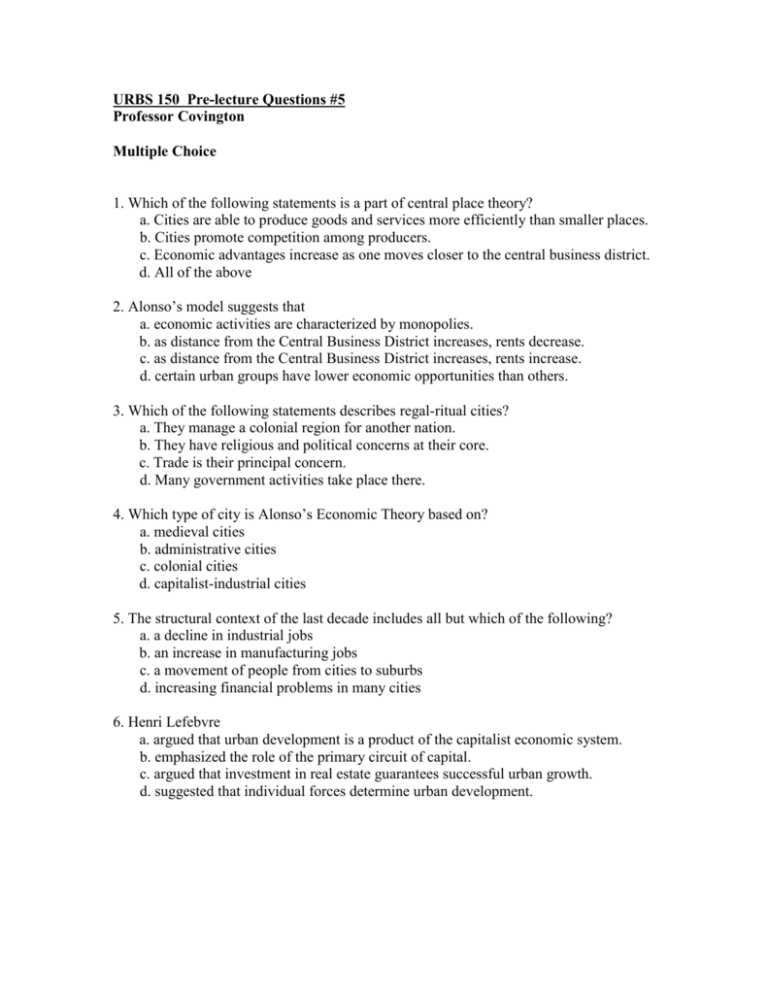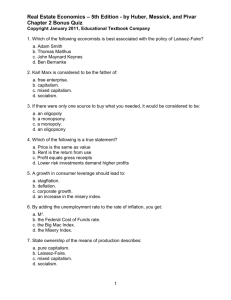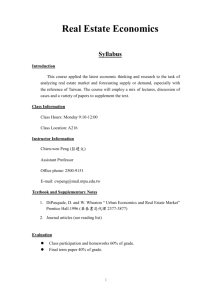URBS 150 Pre-lecture Questions: Urban Studies
advertisement

URBS 150 Pre-lecture Questions #5 Professor Covington Multiple Choice 1. Which of the following statements is a part of central place theory? a. Cities are able to produce goods and services more efficiently than smaller places. b. Cities promote competition among producers. c. Economic advantages increase as one moves closer to the central business district. d. All of the above 2. Alonso’s model suggests that a. economic activities are characterized by monopolies. b. as distance from the Central Business District increases, rents decrease. c. as distance from the Central Business District increases, rents increase. d. certain urban groups have lower economic opportunities than others. 3. Which of the following statements describes regal-ritual cities? a. They manage a colonial region for another nation. b. They have religious and political concerns at their core. c. Trade is their principal concern. d. Many government activities take place there. 4. Which type of city is Alonso’s Economic Theory based on? a. medieval cities b. administrative cities c. colonial cities d. capitalist-industrial cities 5. The structural context of the last decade includes all but which of the following? a. a decline in industrial jobs b. an increase in manufacturing jobs c. a movement of people from cities to suburbs d. increasing financial problems in many cities 6. Henri Lefebvre a. argued that urban development is a product of the capitalist economic system. b. emphasized the role of the primary circuit of capital. c. argued that investment in real estate guarantees successful urban growth. d. suggested that individual forces determine urban development. 7. Which of the following is NOT an illustration of an urban area as a theme park? a. Disney’s Main Street b. BosWash c. Universal City, California’s CityWalk d. Baltimore’s Harborplace 8. According to David Harvey, a. real estate investment takes place in a free market. b. governments shape a city’s use of space. c. all neighborhoods are characterized by similar real estate buying and selling patterns. d. capitalists and government agencies are opposed to each other. 9. Which of the following statements describes “welfare capitalism”? a. It is a market system in which the government provides workers with subsidies. b. It exists when private corporations administer welfare programs. c. It eliminates the conflicts between the working class and the different levels of government. d. None of the above 10. Which of the following statements describes Castells’s concept of the mode of development? a. It is based on the similar Marxist concept of mode of production. b. It can be used to understand industrial growth in suburbs. c. It emphasizes today’s need to discover and apply new sources of energy. d. Both a and b 11. In the context of the United States, what does economic restructuring include? a. a decline in the proportion of manufacturing jobs in overall employment b. a rise in entry-level jobs for lower-skilled workers c. a rising skills mismatch d. Both a and c 12. The world-system perspective a. suggests that capitalism exists only in Western countries. b. supports the idea that soon all cities will be part of the “core.” c. links changes in cities to the development of a global economy. d. suggests that cities in poor countries benefit greatly from globalization. 13. Which of the following areas contains the highest concentrations of poverty? a. central cities b. suburban areas c. nonmetropolitan areas d. rural areas 14. Poverty results in the serious problem of homelessness in more developed countries.











